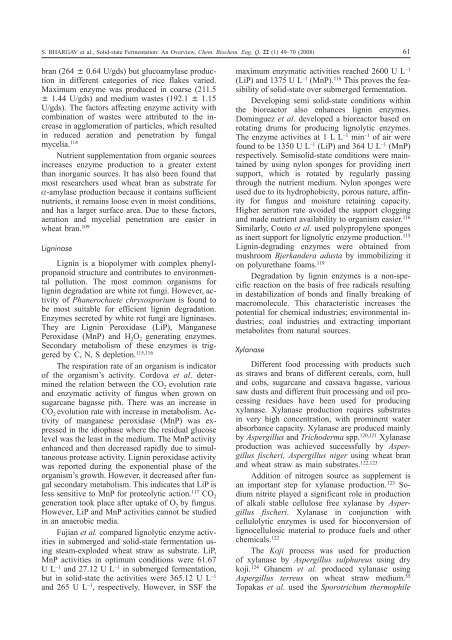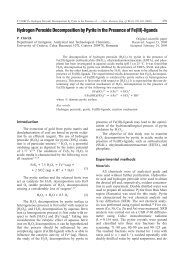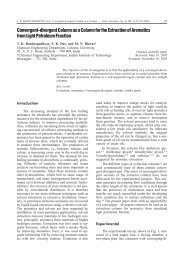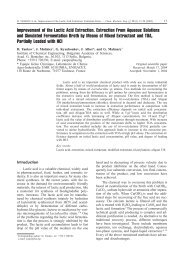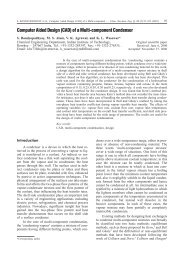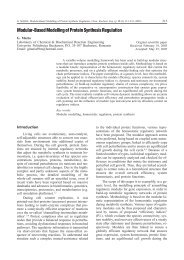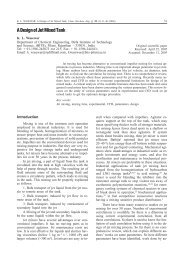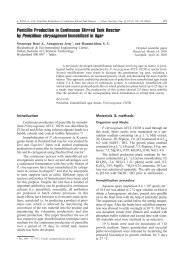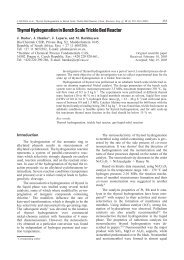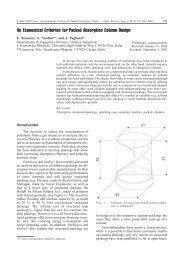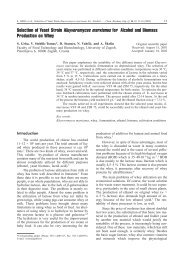60 S. BHARGAV et al., <strong>Solid</strong>-state <strong>Fermentation</strong>: <strong>An</strong> <strong>Overview</strong>, Chem. Biochem. Eng. Q. 22 (1) 49–70 (2008)ported due to the combined effects of nutrients inthem. 103Various other substrates like wheat bran, oilcakes such as groundnut oil cake, canola meal,rapeseed meal and soybean meal when supplementedwith surfactants resulted in higher productionof phytase. Aspergillus ficcum was used forphytase production on canola meal using SSF. 104Extra cellular phytase produced using thermo-tolerantAspergillus niger was maximum with cowpeameal. Increase in membrane permeability of fungushas been reported to be the optimum cause forphytase enhancement in SSF. 105L-glutaminaseL-glutaminase is used as antileukaemic and flavorenhancing agent. <strong>Solid</strong>-state fermentation wasfound to be more suitable than submerged fermentationfor biosynthesis of L-glutaminase using Pseudomonasflourescens, as 25-fold enhancement wasobtained. 106 The moisture of substrate highly effectsenzyme production. L-glutaminase was produced byyeast Zygosacharomyces rouxii using wheat branand sesame oil as substrate with s = 64.2 % moisture,t = 48 h old inoculum and = 30 °C incubationtemperature. Addition of 10 % NaCl and seawaterto wheat bran and sesame oil enhanced enzymeproduction. The enzyme produced fromwheat bran and sesame oil cake in dry state was 2.2and 2.17 U/gds but with supplementation, the concentrationincreased to 7.5 and 11.61 U/gds respectively.107 Beauveria spp. an alkalophilic and salt-tolerantfungus isolated from marine sediment, wasused for L-glutaminase production using seawater-basedmedium supplemented with L-glutamine(w = 0.25 %) as substrate. 108 Seawater being a naturalreserve for marine organisms can provide themsufficient nutrients when used as supplement in SSFfor production of industrially important enzymes.AmylaseAmylase has potential application in a numberof industrial processes such as food, fermentation,textiles and paper industries. The two major classesof starch degrading amylases are glucoamylasesand -amylase. <strong>Solid</strong>-state fermentation holds tremendouspotential for production of these enzymesindustrially on a large scale.Production of -amylase is not limited to fungalcultures but it is also done by bacterial culturesof genus Bacillus. Bacterial cultures reduce the timerequired for fermentation, reducing a lot of expenditureinvolved. Wheat bran has been reported to bethe best substrate even for bacterial cultures. Babuand Satyanarayana produced -amylase with Bacilluscoagulans in SSF using wheat bran as substrateand supplemented with tap water as moisteningagent. They compared the production of enzyme indifferent vessels. 109 Ramesh and Lonsane produced-amylase with Bacillus licheniformis M27 underSSF conditions, using wheat bran as substrate. 38<strong>An</strong> advantage of SSF over submerged fermentationis the inhibition of catabolic repression byregulation of end product synthesis from the productformed. -amylase production by Bacilluslicheniformis decreased from 420 to 30 units mL –1with increase in fraction of starch from 0.2 to 1 %in SMF. However, in SSF the enzyme activity enhanced29-fold with a 42 times increase in concentrationof starch. Hence, inhibition of enzyme byproduct is overruled in solid-state fermentation. 110Ramachandran et al. used coconut oil cake, a dryproduct obtained from copra for production of-amylase with Aspergillus niger in SSF.Supplementation with starch, peptone and glucoseincreased the enzyme synthesis. 111Glucoamylase is still produced by large-scalesubmerged fermentation, but the production cost remainshigh in all respects. There are less reports ofglucoamylase production in SSF. However, cost ofproduction is lower in SSF. Cost reduction can beachieved by using cheaper substrates such as agro--industrial residues. Selection of the proper substrateis an important parameter for maximum enzyme activity.Ellaiah et al. optimized different substrateslike wheat bran, green gram husk, black gram bean,barley flour, jowar flour, maize bran, rice bran, andwheat rawa for maximum glucoamylase productionwith Aspergillus spp. under SSF. However, wheatbran showed maximum enzyme activity to be 247Ug –1 . Supplementation of w = 1 % fructose andw = 1 % urea enhanced enzyme activity. A veryhigh moisture content of 80 % favored maximumenzyme production. 112 Tea waste was used as substratefor maximum glucoamylase production usingAspergillus niger. Supplementation of tea wastewith mineral solution containing salts such as K,Mn, Mg, Zn and Ca resulted in 198.4 IU/gds ofenzyme. The results were at t = 96 h with 4 %inoculum, 60 % moisture, and pH of 4.5. Supplementationwith w = 1 % sucrose enhanced enzymeactivity to 212.6 IU/gds at 96 h. Further addition ofw = 1 % malt extract increased enzyme activity to226 IU/gds at 72 h after inoculation. 113<strong>An</strong>to et al. produced glucoamylase using riceflakes (categorized as coarse, fine and medium),wheat bran and rice powder as substrates withAspergillus spp. HA-2. Supplementation of sucroseas carbon source to wheat bran and glucose tocoarse, medium waste enhanced enzyme production.Addition of yeast extract and peptone to thesubstrates also enhanced enzyme production. Maximumenzyme production was obtained in wheat
S. BHARGAV et al., <strong>Solid</strong>-state <strong>Fermentation</strong>: <strong>An</strong> <strong>Overview</strong>, Chem. Biochem. Eng. Q. 22 (1) 49–70 (2008) 61bran (264 0.64 U/gds) but glucoamylase productionin different categories of rice flakes varied.Maximum enzyme was produced in coarse (211.5 1.44 U/gds) and medium wastes (192.1 1.15U/gds). The factors affecting enzyme activity withcombination of wastes were attributed to the increasein agglomeration of particles, which resultedin reduced aeration and penetration by fungalmycelia. 114Nutrient supplementation from organic sourcesincreases enzyme production to a greater extentthan inorganic sources. It has also been found thatmost researchers used wheat bran as substrate for-amylase production because it contains sufficientnutrients, it remains loose even in moist conditions,and has a larger surface area. Due to these factors,aeration and mycelial penetration are easier inwheat bran. 109LigninaseLignin is a biopolymer with complex phenylpropanoidstructure and contributes to environmentalpollution. The most common organisms forlignin degradation are white rot fungi. However, activityof Phanerochaete chrysosporium is found tobe most suitable for efficient lignin degradation.Enzymes secreted by white rot fungi are ligninases.They are Lignin Peroxidase (LiP), ManganesePeroxidase (MnP) and H 2 O 2 generating enzymes.Secondary metabolism of these enzymes is triggeredby C, N, S depletion. 115,116The respiration rate of an organism is indicatorof the organism’s activity. Cordova et al. determinedthe relation between the CO 2 evolution rateand enzymatic activity of fungus when grown onsugarcane bagasse pith. There was an increase inCO 2 evolution rate with increase in metabolism. Activityof manganese peroxidase (MnP) was expressedin the idiophase where the residual glucoselevel was the least in the medium. The MnP activityenhanced and then decreased rapidly due to simultaneousprotease activity. Lignin peroxidase activitywas reported during the exponential phase of theorganism’s growth. However, it decreased after fungalsecondary metabolism. This indicates that LiP isless sensitive to MnP for proteolytic action. 117 CO 2generation took place after uptake of O 2 by fungus.However, LiP and MnP activities cannot be studiedin an anaerobic media.Fujian et al. compared lignolytic enzyme activitiesin submerged and solid-state fermentation usingsteam-exploded wheat straw as substrate. LiP,MnP activities in optimum conditions were 61.67UL –1 and 27.12 U L –1 in submerged fermentation,but in solid-state the activities were 365.12 U L –1and 265 U L –1 , respectively. However, in SSF themaximum enzymatic activities reached 2600 U L –1(LiP) and 1375 U L –1 (MnP). 118 This proves the feasibilityof solid-state over submerged fermentation.Developing semi solid-state conditions withinthe bioreactor also enhances lignin enzymes.Dominguez et al. developed a bioreactor based onrotating drums for producing lignolytic enzymes.The enzyme activities at 1 L L –1 min –1 of air werefound to be 1350 U L –1 (LiP) and 364 U L –1 (MnP)respectively. Semisolid-state conditions were maintainedby using nylon sponges for providing inertsupport, which is rotated by regularly passingthrough the nutrient medium. Nylon sponges wereused due to its hydrophobicity, porous nature, affinityfor fungus and moisture retaining capacity.Higher aeration rate avoided the support cloggingand made nutrient availability to organism easier. 116Similarly, Couto et al. used polypropylene spongesas inert support for lignolytic enzyme production. 115Lignin-degrading enzymes were obtained frommushroom Bjerkandera adusta by immobilizing iton polyurethane foams. 119Degradation by lignin enzymes is a non-specificreaction on the basis of free radicals resultingin destabilization of bonds and finally breaking ofmacromolecule. This characteristic increases thepotential for chemical industries; environmental industries;coal industries and extracting importantmetabolites from natural sources.XylanaseDifferent food processing with products suchas straws and brans of different cereals, corn, hulland cobs, sugarcane and cassava bagasse, varioussaw dusts and different fruit processing and oil processingresidues have been used for producingxylanase. Xylanase production requires substratesin very high concentration, with prominent waterabsorbance capacity. Xylanase are produced mainlyby Aspergillus and Trichoderma spp. 120,121 Xylanaseproduction was achieved successfully by Aspergillusfischeri,Aspergillus niger using wheat branand wheat straw as main substrates. 122,123Addition of nitrogen source as supplement isan important step for xylanase production. 123 Sodiumnitrite played a significant role in productionof alkali stable cellulose free xylanase by Aspergillusfischeri. Xylanase in conjunction withcellulolytic enzymes is used for bioconversion oflignocellulosic material to produce fuels and otherchemicals. 122The Koji process was used for productionof xylanase by Aspergillus sulphureus using drykoji. 124 Ghanem et al. produced xylanase usingAspergillus terreus on wheat straw medium. 55Topakas et al. used the Sporotrichum thermophile
- Page 1 and 2: S. BHARGAV et al., Solid-state Ferm
- Page 3 and 4: S. BHARGAV et al., Solid-state Ferm
- Page 6 and 7: 54 S. BHARGAV et al., Solid-state F
- Page 8 and 9: 56 S. BHARGAV et al., Solid-state F
- Page 10 and 11: 58 S. BHARGAV et al., Solid-state F
- Page 14 and 15: 62 S. BHARGAV et al., Solid-state F
- Page 16 and 17: 64 S. BHARGAV et al., Solid-state F
- Page 18 and 19: 66 S. BHARGAV et al., Solid-state F
- Page 20 and 21: 68 S. BHARGAV et al., Solid-state F
- Page 22: 70 S. BHARGAV et al., Solid-state F


